Naomi Osaka has withdrawn from the French Open. This sucks – she was very clear about her mental health needs and WTA officials fined her and basically said “fuck you”. Do they care about the wellbeing of their players or no?



This site is made possible by member support. ❤️
Big thanks to Arcustech for hosting the site and offering amazing tech support.
When you buy through links on kottke.org, I may earn an affiliate commission. Thanks for supporting the site!
kottke.org. home of fine hypertext products since 1998.
Entries for May 2021
Was the Microwave Invented to Thaw Out Frozen Hamsters?
We all know that the microwave oven was invented by Raytheon’s Percy Spencer in 1945. What this video presupposes is, maybe it was invented to thaw out frozen hamsters? And somehow James Lovelock, who formulated the Gaia hypothesis, is involved? (via @fourfoldway)
For £50, you get 15 minutes to fill your car up with as many mannequin body parts as you can carry. “Under no circumstances whatsoever will you be able to fill your car boot with hands. Please don’t ask.”
A visually impaired person shares how she uses her iPhone. I hadn’t seen the Braille keyboard option in action before – amazing!
Some literary collective nouns. My favorite by far is “a gruop of proofreaders”.
Political scientist David Faris on the dangers of the Republican revolt against American democracy. “My current level of concern is exploring countries to move to after 2024.”
The Honest Broker Plays the Long Game
Ted Gioia’s newsletter is called Culture Notes of an Honest Broker and in this recent issue, he shares the surprisingly cloak and dagger story of how he came to think of himself as an “Honest Broker”.
“Who, exactly, is this Honest Broker?”
“There’s at least one in every city. But don’t expect their business cards to say ‘Honest Broker’ - that’s just what I call them. But that’s exactly what they are. Sometimes they don’t even have an official position. But they are the key to everything.”
He proceeded to explain how Honest Brokers play a hidden but vital role in communities without a history of legal protections and stable institutions. Their influence and power is built solely on a reputation for straight talk and trustworthy dealings. “They are true brokers, intermediaries between others. They aren’t going to participate in your deal, no matter what it is. They are go-betweens, really. But do not underestimate the power of this kind of brokerage. Whatever you need — a loan, a building permit, political influence, a place to land a private jet, whatever — they will introduce you to the right people and steer you away from the sharks.
Reading Gioia’s essay, I realized that with my work here on kottke.org, I’ve been unknowingly trying to be that Honest Broker for you folks. I don’t always live up to that ideal, but I work pretty hard so that everything I write and link to here is stuff that I genuinely enjoy and find interesting and believe that you will as well.
Do not underestimate the power of this kind of brokerage…the Honest Broker plays the long-term game, mate. Over time, that scrupulous fidelity and reputation for trustworthy advice beats out all other strategies. The Honest Broker is irreplaceable, and all the more so when other guides have become unreliable.
All it takes is 23 years of consistent effort…and presto! :)
Inside Citizen’s Dangerous Effort to Cash In On Vigilantism. This is just evil, deeply immoral stuff that is making society more dangerous to live in.
Cate Blanchett in The Four Temperaments
I didn’t wake up this morning knowing I needed to hear Cate Blanchett saying “I love you” over and over again while looking right at me, but now that it’s happened I could not have imagined it going any other way. (She also says “I don’t love you” several times but we’re going to ignore that.)
Bent Reality
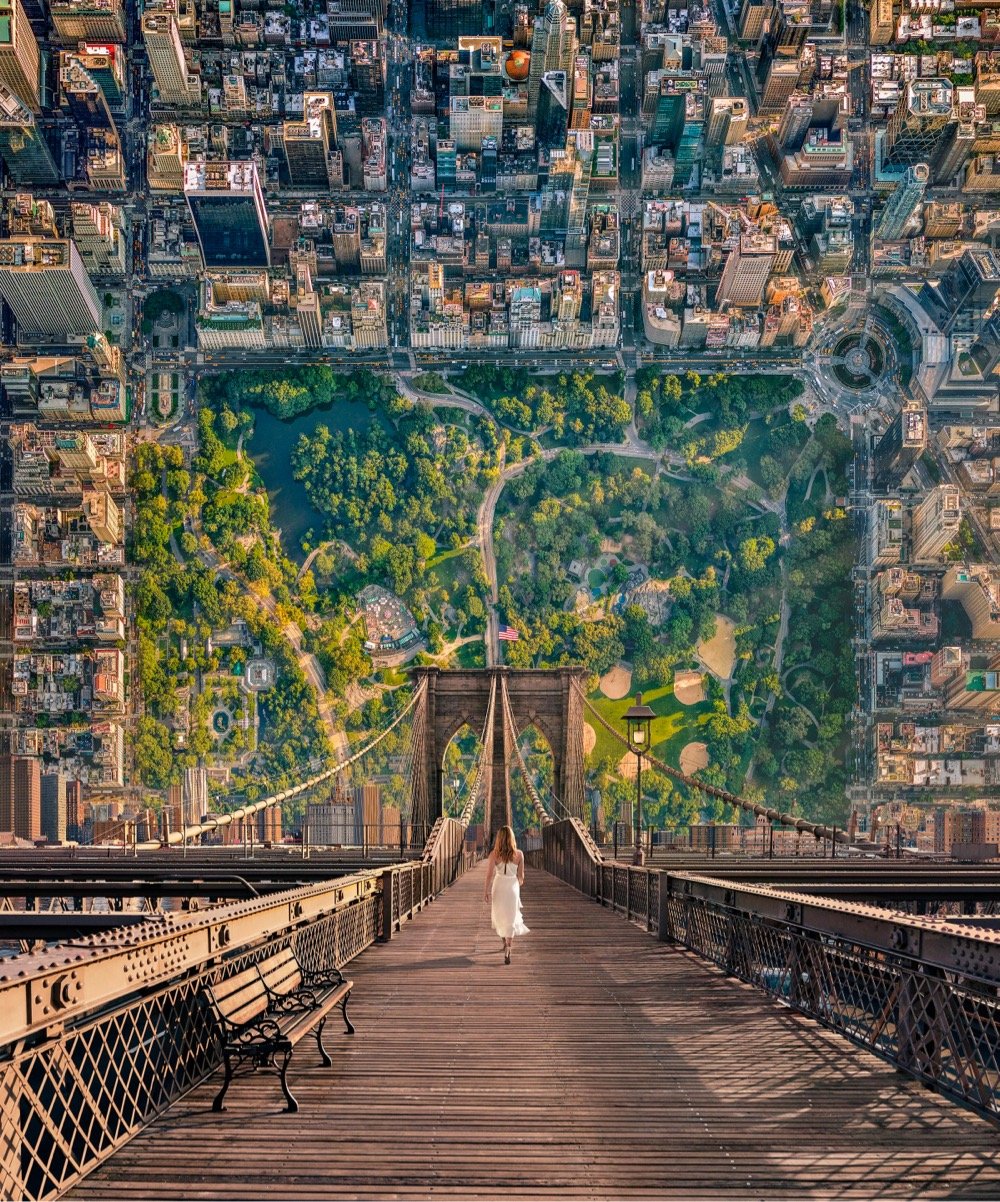


These surrealistic images were created by Cream Electric Art for a United Airlines ad campaign. Here’s a quick behind-the-scenes on how the Route 66 image was constructed. Prior art: Berg’s Here & There map of Manhattan, Inception, and these curved cityscape panoramas. (via moss & fog)
Interesting fact about the 1918 pandemic: “Doctors then hadn’t even figured out that influenza was caused by a virus.” That discovery didn’t happen until the 1930s.
An Engineer Explains All the Different Kinds of Rollercoasters
In this video, rollercoaster engineer Korey Kiepert talks about all the different types of rollercoasters that you’ll see at an amusement park, including wooden, terrain, launched, hyper, out-and-back, and wild mouse coasters.
So, when we design a roller coaster, we’re trying to take something that’s very much driven by the same codes that would be used to design a building. And we’re working with those to create something that gives you the illusion that it’s daring and adventurous but, at the same time, it’s all very controlled.
See also Every Bridge For Every Situation, Explained by an Engineer. (via the kid should see this)
Eric Carle, Author of The Very Hungry Caterpillar, Has Passed On
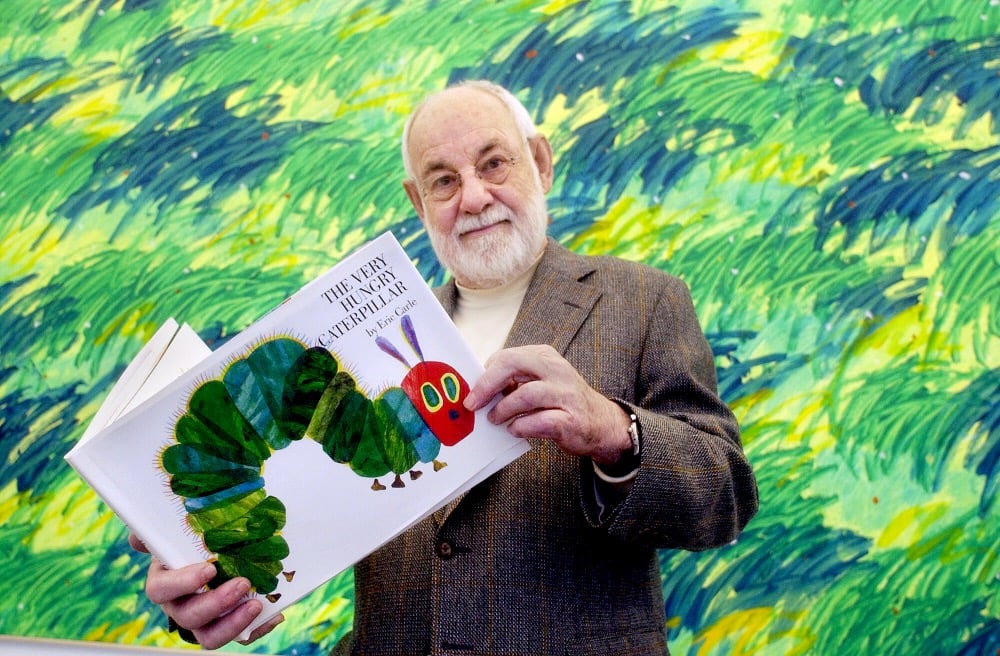
Beloved children’s book author Eric Carle died this past weekend at the age of 91 and this is one of the best openings to an obituary I can recall reading:
When a fictional caterpillar chomps through one apple, two pears, three plums, four strawberries, five oranges, one piece of chocolate cake, one ice cream cone, one pickle, one slice of Swiss cheese, one slice of salami, one lollipop, one piece of cherry pie, one sausage, one cupcake and one slice of watermelon, it might get a stomach ache.
But it might also become the star of one of the best-selling children’s books of all time.
Eric Carle, the artist and author who created that creature in his book “The Very Hungry Caterpillar,” a tale that has charmed generations of children and parents alike, died on Sunday at his summer studio in Northampton, Mass. He was 91.
I’ve written about Carle and his most famous creation, The Very Hungry Caterpillar, a couple of times here — I can still remember the first time my son read (or, more likely, recited from memory) the list of everything the caterpillar ate on Saturday, including all of his adorable pronunciations.
The Very Hungry Caterpillar was certainly one of my favorite books as a kid — along with Cloudy With a Chance of Meatballs, Richard Scarry’s Busy, Busy Town & Cars and Trucks and Things That Go, and the Frog & Toad books — and it was one of the first books we read to our kids. I remember very clearly loving the partial pages and the holes. Holes! In a book! Right in the middle of the page! It felt transgressive. Like, what else is possible in this world if you can do such a thing?
You can see Carle at work in his workshop from an episode of Mister Rogers’ Neighborhood in 1998. I particularly appreciated this short exchange:
Rogers: In this, there’s just no mistakes, is there?
Carle: No, you can’t make mistakes really.
How Does America’s Response to Climate Change Look From Abroad?
For this video, the NY Times talked to several people from around the world (Britain, Zimbabwe, Norway, India, etc.) about what they think about how the United States is approaching climate change and other environmental challenges. Spoiler alert: there is a lot of incredulity about how shitty America is doing in this area. And that matters because what happens here affects everyone around the world.
See also What Does U.S. Health Care Look Like Abroad? and What Do U.S. Elections Look Like Abroad?
“If Democracy Is Dying, Why Are Democrats So Complacent?”
For The Atlantic, Luke Savage writes that Democrats have to put their money where their mouth is when it comes to protecting American democracy.
If you’ve followed recent Democratic messaging, you’ll have heard that American democracy is under serious attack by the Republican Party, representing an existential threat to the country. If you’ve followed Democratic lawmaking, you’d be forgiven for thinking that the threat is actually a rather piddling one. The disconnect, in this case, isn’t attributable to Democratic embellishment, but to inexcusable complacency.
Without meaningfully reforming the rules of the Senate, the Biden administration & Congressional Democratic leadership basically gets to pass one substantial bill per year (through budget reconciliation). That’s it. If Democrats lose the House in 2022, which seems likely or even certain without the passage of a federal voting rights bill, then it’s only one or two bills. And then maybe Democrats don’t see the White House, a Senate majority, and a House majority for a generation and we’ll all have to ask ourselves whether we actually like living in a de facto nationalistic one-party state.
“Immunity to the coronavirus lasts at least a year, possibly a lifetime, improving over time especially after vaccination, according to two new studies.” What amazing news this would be if these studies prove true.
Facebook is not listening to your offline conversations with friends, but here’s how it knows to show you ads about those convos. “If my phone is regularly in the same GPS location as another phone, they take note of that.”
Leslie Odom Jr. Teaches You Philly Slang
Singer and actor Leslie Odom Jr., who grew up in Philadelphia and who you may know from Hamilton and who is wearing an amazing purple sweater in this video, breaks down some Philly slang for us, including jawn, Mummers, MAC machine, old head, water ice, and outta pocket.
What If We Just Stopped Calling the Cops? “For decades, the solution to Black Americans’ distrust of cops has often been to not call them. Now white people are catching on too.”
Hisako Koyama, the Woman Who Stared at the Sun
In the history of science, there are women who have made significant contributions to their field but haven’t gotten the recognition that their male peers have. The field of astronomy & astrophysics in particular has had many female pioneers — Vera Rubin, Cecilia Payne-Gaposchkin, Annie Jump Cannon, Nancy Grace Roman, Maria Mitchell, Jocelyn Bell Burnell, Henrietta Swan Leavitt, Caroline Herschel, Williamina Fleming, and many others. Add to that list Hisako Koyama, a Japanese astronomer whose detailed sketches of the Sun over a 40-year period laid the foundation for a 400-year timeline of sunspot activity, which has aided researchers in studying solar cycles and magnetic fields.
Ms. Koyama was a most unusual woman of her time. As a scientist, she bridged the amateur and professional world. She preferred “doing” activities: observing, data recording, interacting with the public, and writing. No doubt many Japanese citizens benefited from personal interaction with her. The space and geophysics community continues to benefit from her regular and precise observations of the Sun. Although we know very little of her young personal life other than she was relatively well educated and had a father who supported her desire to view the skies by providing a telescope, we can see from snippets in Japanese amateur astronomy articles that she had a passion for observing, as revealed in her 1981 article: “I simply can’t stop observing when thinking that one can never know when the nature will show us something unusual.”
Here are a few of her sunspot sketches, the top two done using her home telescope and the bottom one using the much larger telescope at the National Museum of Nature and Science (that shows the largest sunspot of the 20th century):


(via the kid should see this)
George Floyd Is Dead Because America Is a Racist Country. “For 46 years, he had managed to survive the pillaging of his family’s wealth. He outlasted a racist education system. He withstood the prejudice of the criminal justice system.”
This Chemistry Nobel Prize winner was very vocal about Covid-19 – and very wrong, even dangerously wrong. And he wasn’t the only one. How should society & the scientific community react to this sort of thing?
1000 Musicians Play Rock Songs From Nirvana, Queen, etc.
Before I clicked play on the video embedded above of 1000 musicians playing Learn to Fly by the Foo Fighters, I assumed it was going to be kind of a mess, a muddled wall of sound. Instead, I was surprised to hear something almost magical, a rock anthem played with the fullness of a orchestra or chorus, the band and the crowd merged into a single, gorgeously layered entity. I was moved by it, almost immediately. All those drummers pounding away on their drum kits in unison! You can check out this playlist for more 1000 musician versions of rock songs, including Seven Nation Army (White Stripes), We Will Rock You (Queen), and Smells Like Teen Spirit (Nirvana):
I also have to say that these videos hit me harder now, 15 months into a global pandemic that kept my family and I separated from all but a narrow slice of the world, than they would have before, especially now that things are starting to loosen up a bit and I am able to safely socialize with other vaccinated folks in person. Seeing thousands of people collectively engaged something so joyful is both a reminder of what we lost during the pandemic and what we stand to gain if we can manage to contain the virus worldwide. I think this is the reason why this video of a flash mob performing Ode to Joy went viral early on in the pandemic. All the feels. (another great find via openculture)
Your Wild and Precious Life
How do you know what to do with your life? The introduction to this new and uncharacteristically existential Kurzgesagt video is some real truth:
Wrapping your mind around your life is pretty hard, because you are up to your neck in it. It’s like trying to understand the ocean while learning how to swim. On most days you are busy just keeping your head above water. So it is not easy to figure out what to do with your life and how to spend your time. There are a million distractions. Your family, friends and romantic partners, boring work, and exciting projects. Video games to play and books to read. And then there is your couch that somebody needs to lie on. It’s easy to get lost.
Thinking about this stuff can be kind of a downer, as the writer of this video admits in a comment:
It’s so easy to get lost in your daily life: there are so many “urgent” and “annoying” things that you forget that actually every day is special, sort of. And even more so the days we have with friends and family. I know watching a video like this can hit pretty hard. But at least for me, the message it tries to convey does make me actually change my behavior. Reprioritize things. You know. Hope it had a similar effect for some of you.
See also Your Life in Weeks by Tim Urban.
The housing market in the US right now is bonkers. “There are now more Realtors than listings.”
We Know What You Did During Lockdown
After watching this short film on how much data private companies are able to gather about you (data that we willingly give them in some cases), you might be forgiven for thinking that, never mind some far flung future, we are living in a full-on dystopia right now. The set design, the acting, the positioning of the tables, the see-through table tops, the laptop vs. notebook…this was really well done. When the interrogator got up from his desk, I viscerally felt the invasion of privacy.
The World’s Greatest Card Trick Can’t Be Taught
World-renowned magician David Berglas, now 94 years old, does a card trick that’s so effortlessly simple and dazzling that no one has figured it out and Berglas himself says it cannot be taught.
The trick is a version of a classic plot of magic, called Any Card at Any Number. These tricks are called ACAAN in the business.
ACAAN has been around since the 1700s, and every iteration unfolds in roughly the same way: A spectator is asked to name any card in a deck — let’s say the nine of clubs. Another is asked to name any number between one and 52 — let’s say 31.
The cards are dealt face up, one by one. The 31st card revealed is, of course, the nine of clubs. Cue the gasps.
There are hundreds of ACAAN variations, and you’d be hard pressed to find a professional card magician without at least one in his or her repertoire. (A Buddha-like maestro in Spain, Dani DaOrtiz, knows about 60.) There are ACAANs in which the card-choosing spectator writes down the named card in secrecy; ACAANs in which the spectator shuffles the deck; ACAANs in which every other card turns out to be blank.
For all their differences, every ACAAN has one feature in common: At some point, the magician touches the cards. The touch might be imperceptible, it might appear entirely innocent. But the cards are always touched.
With one exception: David Berglas’s ACAAN. He would place the cards on a table and he didn’t handle them again until after the revelation and during the applause. There was no sleight of hand, no hint of shenanigans. It was both effortless and boggling.
Of course, his unwillingness to reveal how the trick works or even that he is unable to show someone else how to do it could be part of the trick. But in recent years, Berglas has pulled back the curtain on most of his other tricks, like the time he made a grand piano vanish into thin air, explained by Berglas himself in a YouTube video:
But not this card trick, as the author of the Times’ piece discovers. A delightful read.
Update: Part of the reason I love publishing posts like this (about magic and unknowable tricks) is that I know I’m gonna get some great feedback. In 2011, Richard Kaufman wrote a book called The Berglas Effects with the participation of Berglas himself in which his version of ACAAN is explained at length. Here’s Kaufman himself remarking on the Times story:
The writer is under the odd impression that “The Berglas Effect” has never been explained and is not explained in my book. There are 75 pages devoted to it.
So…huh. I wonder what the book says about the trick? (thx, bill)
For those who are not vaccinated, Covid-19 case/hosp./death levels are still relatively high in many parts of the US. Something to keep in mind that the state and national averages we’re seeing don’t reflect.
The Great Wave Off Kanagawa by Hokusai, Explained
Great Art Explained is a super YouTube series that I am somehow just now learning about that, uh, explains great art. Host James Payne has done about a dozen videos on pieces like Artemisia Gentileschi’s Judith Beheading Holofernes, Warhol’s Marilyn Diptych, and Untitled (Skull) by Jean-Michel Basquiat. His latest is about The Great Wave Off Kanagawa by Katsushika Hokusai.
In 1639 Japan closed its borders and cut itself off from the outside world. Foreigners were expelled, Western culture was forbidden, and Entering or leaving Japan was punishable by Death. It would remain that way for over 200 years.
It was under these circumstances that a quintessentially Japanese art developed. Art for the people that was consumed on an unprecedented scale.
Really interesting stuff. Subscribed.
See also several different versions of The Great Wave print and The Art of Traditional Japanese Printmaking. (via open culture)
Trillions and Trillions and Trillions of Stars

This is a photo of a tiny tiny snippet of the universe, taken by the Hubble Space Telescope. Every object you see in the photo is a staggeringly massive galaxy that contains hundreds of billions of stars along with all sort of other things.
Our own galaxy, the Milky Way, is well over one hundred thousand light years across. We only see a pitiful portion of it. Although it contains several hundred billion stars in its expanse, we can only see a fraction of a fraction of them.
And even that doesn’t fully capture the essence of a galaxy, which also has planets, gas, dust, dark matter, and more. Galaxies are colossal objects, their true nature only becoming apparent to us a century ago.
I know I’ve posted photos like this before, but every time I see something like this, my mind boggles anew at the sheer scale and magnitude of it all and I just have to share it.
P.S. And Earth contains the only sentient life in the entire universe? Lol.
When a Raindrop Falls in the US, Where Does It End Up?


Using data from the United States Geological Survey, River Runner visualizes the path taken by a raindrop from its landing spot to its eventual endpoint. Just click on any spot in the US and it maps out the path the drop would take, complete with a satellite fly-through of the route. I spent many happy minutes playing with this, although the endpoint of “Canada” for a raindrop that lands in my Vermont yard was somewhat unsatisfying.
See also The Marvelous Mississippi River Meander Maps and a map of all of the rivers in the US. (via waxy)
A Map of the Internet 2021
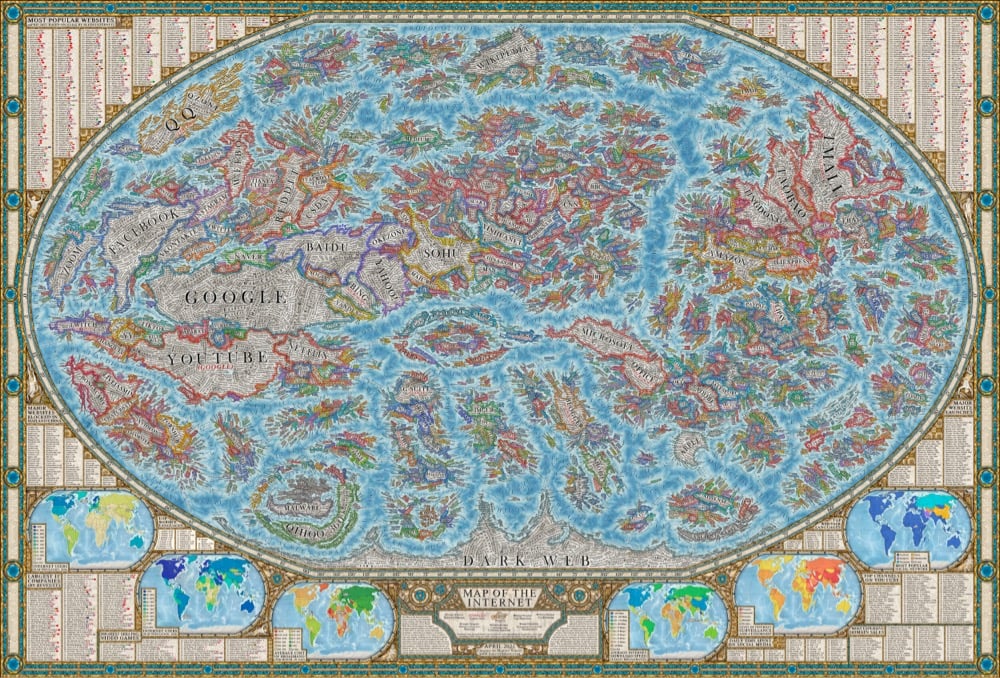
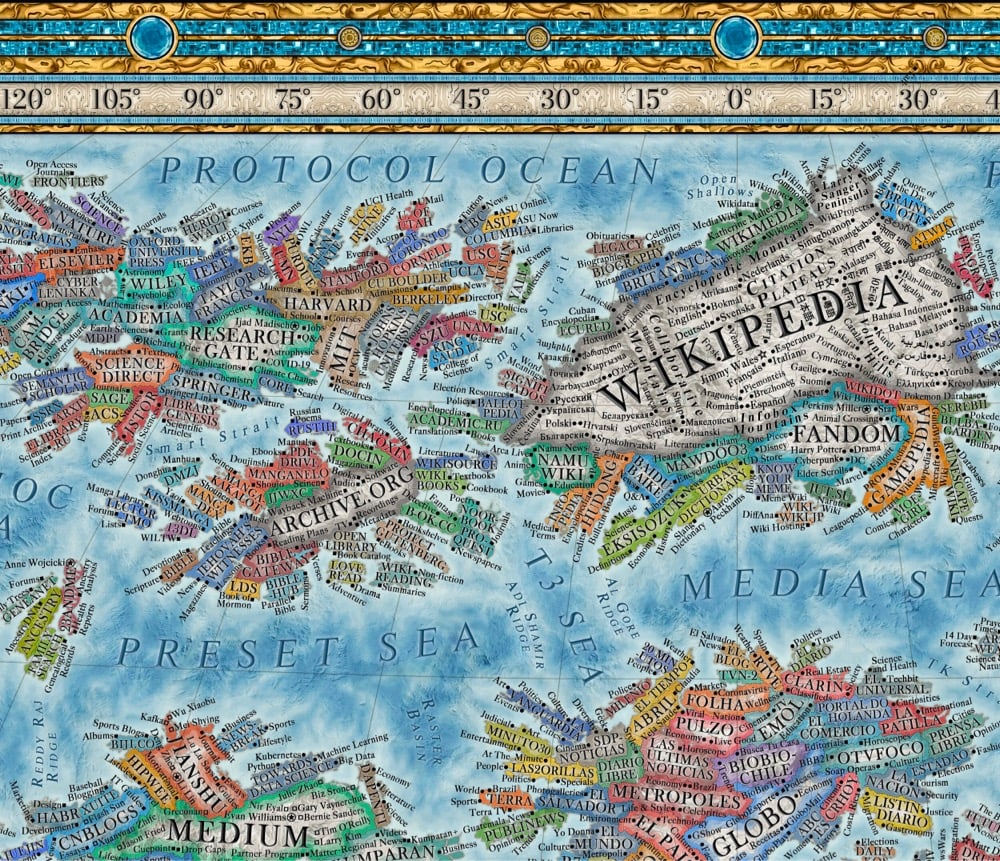
Translating sites, search engines, social networks, browsers, ISPs, and other internet entities into geographic features, Martin Vargic has created a map of the internet circa 2021.
It includes several thousand of some of the most popular websites, represented as distinct “countries”, which are grouped together with others of similar type or category, forming dozens of distinct clusters, regions and continents that stretch throughout the map, such as “news sites”, “search engines”, “social networks”, “e-commerce”, “adult entertainment”, “file sharing”, “software companies” and so much more. In the center of it all can be found ISPs and web browsers, which form the core and backbone of the internet as we know it, while the far south is the domain of the mysterious “dark web”.
An update on the support for Black Lives Matter in the US. “Republicans and white people have actually become less supportive of Black Lives Matter than they were before the death of George Floyd.”
100 Visions of Motherhood



Curated by The Luupe, this is “a collection of photographs and words celebrating the complexities of motherhood”. And somehow even 100 photographs don’t adequately capture the vast experience of motherhood around the world. Photos above by Dee Williams, Brittany Marcoux, Diane Allford (via storythings)
The evolution of butts. “Gently turn that blobby body around, and gaze deep into its marvelous, multifunctional anus.”
A Visualization of American Age Generations
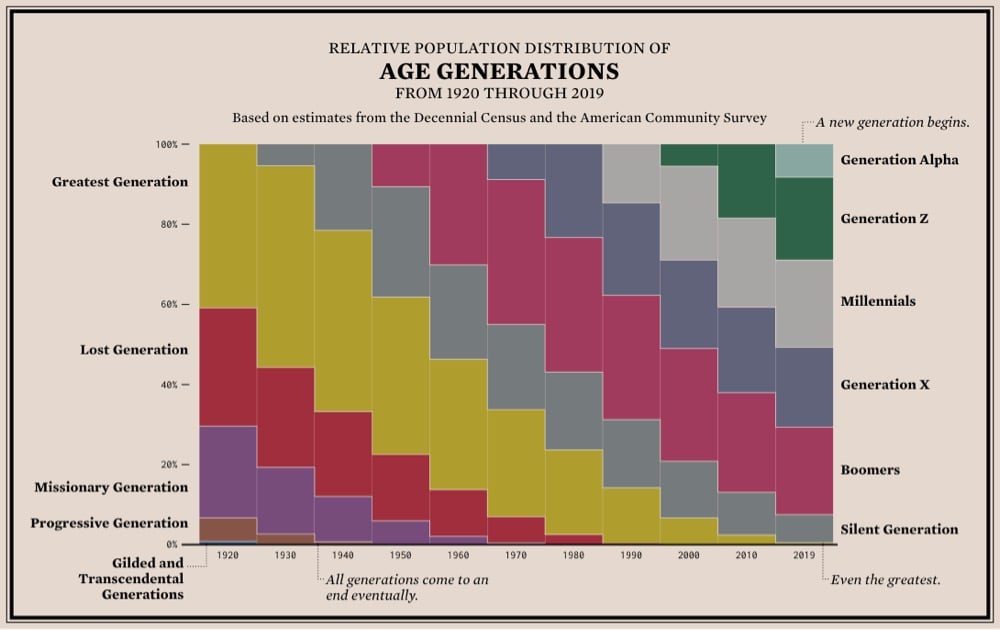
From Flowing Data, a stacked bar chart showing the relative population distribution of age generations from 1920 to the present. The thing that’s really apparent to me in this graph is how the size, increased life expectancy, and better quality of life of the Silent and (especially) Baby Boomer generations really shifted the social order in America. It’s a triple whammy: this large group of very healthy people stuck around so much longer than the previous generations that they were able to keep their wealth and political/corporate power instead of handing it off to the next generations. It’s a generational firewall — they didn’t leave any room for their children or grandchildren. Instead, Gen X and Millennials got branded as lazy/apathetic and financially careless. (via @mikey_two)
A profile of Vermont governor Phil Scott, who is a Republican thriving in the most liberal state in the US. As a Vermonter, I can say his handling of the pandemic was very good, conservative in the best sense.
The Continuing Trauma of the Pandemic
Because of the remarkable Covid-19 vaccines, the pandemic is easing in America. In many parts of the country, things are returning to some semblance of normal, whatever that means. But many will continue to struggle and come to terms with what happened for awhile longer. Ed Yong, What Happens When Americans Can Finally Exhale:
But there is another crucial difference between May 2020 and May 2021: People have now lived through 14 months of pandemic life. Millions have endured a year of grief, anxiety, isolation, and rolling trauma. Some will recover uneventfully, but for others, the quiet moments after adrenaline fades and normalcy resumes may be unexpectedly punishing. When they finally get a chance to exhale, their breaths may emerge as sighs. “People put their heads down and do what they have to do, but suddenly, when there’s an opening, all these feelings come up,” Laura van Dernoot Lipsky, the founder and director of the Trauma Stewardship Institute, told me. Lipsky has spent decades helping people navigate the consequences of natural disasters, mass shootings, and other crises. “As hard as the initial trauma is,” she said, “it’s the aftermath that destroys people.”
And it wasn’t just the pandemic:
Not everyone will feel this way. Perhaps most Americans won’t. In past work, Silver, the UC Irvine psychologist, found that even communities that go through extreme traumas, such as years of daily rocket fire, can show low levels of PTSD. Three factors seem to protect them: confidence in authorities, a sense of belonging, and community solidarity. In the U.S., the pandemic eroded all three. It reduced trust in institutions, separated people from their loved ones, and widened political divisions. It was something of a self-reinforcing disaster, exacerbating the conditions that make recovery harder.
Also, let’s not forget: “Globally, the pandemic is set to kill more people in 2021 than in 2020.”
The Last Words of Quintin Jones
Last week, I posted about Texas death row inmate Quintin Jones and his plea for clemency in the face of his pending execution. Again, here is his video message to Texas governor Greg Abbott:
On Wednesday evening, in the presence of two outside witnesses, Texas killed Quintin Jones. Two journalists who were to bear witness to the execution for the public were not called into the prison by officials who somehow “forgot” to do so:
Absent were two journalists who had been scheduled to attend the execution but whom prison officials said they had accidentally failed to summon.
Before he died, a video director for the NY Times recorded a short video of Jones’ last words to the public, in which he thanked everyone for helping him be a better person and even asked viewers to consider the trauma that death row prison guards endure in the course of doing their jobs. A separate statement of his last words was recorded by prison officials:
“Love all my friends and all the friendships that I have made,” Mr. Jones said, according to those state prison records. “They are like the sky. It is all part of life, like a big full plate of food for the soul. I hope I left everyone a plate of food full of happy memories, happiness and no sadness.”
Then he said, “I’m done, warden.” He was pronounced dead at 6:40 p.m.
That same day, Governor Abbott, who is a member of the so-called “pro-life” Republican party, signed a law that bans abortions in Texas after a fetal heartbeat can be detected, which is before many women are even aware they are pregnant.
A possibly novel coronavirus that may have jumped from dogs into humans has been detected in samples taken in Malaysia in 2017/18. NOT NOW JESUS CHRIST.
Just sent out this week’s @kottke newsletter. It features pencil typography, an infinite hotel, and a majestic thundercloud.
How to Take the Perfect Nap
As someone who is mostly unable to nap, I’ve always felt a twinge of envy towards those who can shut their eyes, drift off for 20 minutes, and awake refreshed & raring to go. Maybe I’ll have better luck after watching this TED-Ed lesson by sleep researcher Sara Mednick (author of Take a Nap! Change Your Life.), which explains when and how long you should nap for optimal results. (via open culture)
Documentary filmmaker Tim Wardle shares 15 things he wished he’d known about documentary filmmaking when he started out. “6. Embrace the nuance and psychological complexity/messiness of real people.”
“Every Child on Their Own Trampoline”
I suspect that if you read this site with any regularity, the pandemic has you thinking about our society’s prioritization of the rights & desires of the individual versus the needs of the community. Using the purchase of a backyard trampoline for his kids as a jumping off point, Jeremy Williams wonders if we haven’t “tipped too far towards private consumption”.
Capitalism pushes us towards private affluence. We aspire to acquire our own things. Shared things are seen as second best, something of an inconvenience. Politics responds accordingly, prioritising economic growth and ‘more money in your pocket’, rather than shared goods and services. So everyone has their own lawnmower while the grass grows long in the park. People get their own exercise bikes or rowing machines, and the gym at the local leisure centre starts to look tired and under-funded. The wealthy pay for childcare or hire a nanny, but the early years nursery closes down.
Having access to your own things looks like progress, but there is a cost. Community is one of the victims. Shared spaces are places where community happens, where people mix and meet. Nobody makes new friends on their own rowing machine, in front of the TV. Inequality is another. Those who can afford their own won’t notice, but those on lower incomes rely much more on shared resources. When a library closes, it’s those on the margins of society who lose access to books, internet access, or a warm place to sit and do their homework. There is also an environmental cost, as private ownership means endlessly duplicated goods, many underused objects across many owners rather than a few well used objects that are shared.
(via dense discovery)
The Micrometeorites All Around Us




Jon Larsen collects and photographs micrometeorites from all over the world, finding them even in urban areas mixed in among terrestrial dust and dirt.
The cosmos is a swirling soup of stardust. Every day, approximately 60 tons of dust from asteroids, comets, and other celestial bodies fall to the Earth. These tiny metallic, alien stones of various shapes, textures, and colors-known as micrometeorites-are some of the oldest pieces of matter in the solar system.
Even though micrometeorites blanket the Earth, scientists have generally only been able to discover them in remote places devoid of human presence, such as Antarctic ice, desolate deserts, and deep-sea sediments. Scientists began searching for micrometeorites in the 1960s, and they predominantly thought the extraterrestrial dust would be impossible to find in urban environments. The conventional wisdom held that densely populated areas had too much man-made sediment that camouflaged the tiny space particles.
But Jon Larsen, a Norwegian jazz musician and creator of Project Stardust, was able to show that it is possible to find micrometeorites in more populated areas. In a study published in January 2017 in the journal Geology, he and his colleagues catalogued more than 500 lustrous micrometeorites (and counting), all recovered from rooftops in urban areas.
Check out Larsen’s Project Stardust for more photos and information on how to hunt for your own. (via the kid should see this)
A Harsh Review, Revisited
This is pretty unusual. Years ago, NY Times film critic AO Scott panned Sarah Silverman: Jesus Is Magic and Silverman, instead of reacting in a typical way, ultimately took his core criticism to heart and changed the way she thought about her comedy. The two of them recently linked up for a conversation about the “challenges both of doing comedy and of writing criticism”, namely that:
You’re supposed to be honest, and you’re supposed to tell the truth and not worry about giving offense. On the other hand, what you do, what I do has a risk of hurting people.
Here’s Silverman:
But the thing you wrote that kind of changed me on a molecular level, which is what, I think, you were kind of onto at the time was completely what I was abusing — and you saw that before anyone else, and you made me see it — which is I’m liberal, so I’m not racist, so I can say the N-word, because I’m illuminating racism.
My intentions were good but ignorant, and it’s funny that in that movie and in the subsequent series I did, my character was ignorant [and] arrogant, but what I didn’t realize was [that I] myself was arrogant [and] ignorant.
I couldn’t help thinking of Pixar’s Ratatouille here, in which the opposite thing happens: the artist changes the critic’s mind.
Pencil Typography

Even just looking at photos of pencils, I can still smell the sheets of mimeograph paper hot off the ditto machine.
Relaxing White Noise Album Made with Lego Bricks
I’m always on the lookout for sounds that help you focus and/or relax; I’ve collected a number of video soundscapes here. If you happen to find the sounds of Lego bricks relaxing, you can add these videos to your routine:
The first one features the sound of Legos being poured and the second one is the sound of someone digging through the Lego bin & snapping pieces together. The full 3.5-hour album of Lego sounds is available to stream on Spotify and Apple Music.
Here’s the company’s press release and a behind-the-scenes look at the album’s production from The Guardian.
The project was devised by Lego’s “head of creative” Primus Manokaran, who describes the streaming-only album as “a collection of soundscapes” designed to promote relaxation and mindfulness. Although the seven tracks, which each run to half an hour in length, are different in their granular details, essentially they were made by Lego pieces being poured out of tubs, sifted through and clicked together.
Manokaran’s team began thinking about why people love Lego during lockdown, and realised that a big hook was how it sounds. Inspired by the online craze for white noise as an aid to relaxation and focus, they began recording. “The acoustic properties of each brick was slightly different,” he says. “It was like composing with 10,000 tiny instruments.”
(thx, martin)
The Pain of the Commute
Luke O’Neil talked to dozens of people who were able to work from home during the pandemic about not missing the commute part of working in an office. A few of the responses:
No one’s stopping anyone who works from home from going out and riding in circles on the subway for 30 minutes before they go back to their desk.
I save roughly $100 a month now. I have time in the morning to take my dog for a long walk every day. I have time in the evening to cook dinner. Commuting is psychological torture and my physical and mental health is significantly better without it.
I love to drive 30 minutes to stare at a different computer
I can’t even calculate the savings in gas, wear on my car, etc. But I can tell you that with nearly two hours back in each of my days, plus the extra 40 minutes or so of making myself presentable to be in close proximity to others, I have been able to reinvest that time in myself. I have been eating better, I have time for the gym, I have time to give my dogs the exercise they need. I know this year has been mentally taxing on so many, but I’ve found these changes work so much better for me.
Why Confederate Lies Live On. “Confederate history is family history, history as eulogy, in which loyalty takes precedence over truth.”
My Recent Media Diet, the Fully Vaccinated Edition
Every few months for the past couple of years, I’ve shared the movies, books, music, TV, and podcasts I’ve enjoyed (or not) recently. Here’s everything I’ve “consumed” since early February, accompanied by a mini review.
How To with John Wilson. What happens near the end of the risotto episode got all the attention, but I’m all about the bag of chips saga. (B+)
Black Art: In the Absence of Light. I can listen to artists and critics talk about art all day long. Also? Everyone in this has impeccable eyewear. (A)
Spirited Away. A masterpiece. (A)
Pfizer-BioNTech Covid-19 Vaccine (BNT162b2). Possibly the best experience of the past 5 years. (A+++++)
Casino Royale. The best of the Daniel Craig Bonds IMO. (B+)
The Lying Life of Adults by Elena Ferrante. Another marvelously constructed world with vibrant characters by Ferrante. (A)
Wandavision. A love letter to television. Watched this with the kids and we all loved it. (A)
Looper. This is perhaps my favorite type of movie: clever sci-fi with a creative director and good actors that give a shit. (A-)
Sonic the Hedgehog. Jim Carrey is the highlight here and not much else. (C+)
The Remains of the Day. One of my favorite movies. I’ve watched this every few years since 1993 and what I get out of it changes every time. Great book too. (A+)
Judas and the Black Messiah. Fantastic performances by Daniel Kaluuya and LaKeith Stanfield. (A)
Zack Snyder’s Justice League. Way too long and nearly pointless. This is what happens when you start treating the director of Legend of the Guardians: The Owls of Ga’Hoole like an auteur. (B-)
A Promised Land by Barack Obama. I recommend the audiobook version of this. You can really tell the bits of the book he cares about and the stuff he phones in a little bit more. The tone of his voice when he talks about Michelle — that love is real. (B+)
Making Sense — The Boundaries of Self. I listened to this conversation with the poet David Whyte at the beginning of March and it was exactly what I needed to hear at that time. I must have listened to his short essay on Friendship about 5 times. (A)
Thunderstruck by Erik Larson. About the invention of the wireless telegraph and the beginning of our abundantly connected world. (B+)
Still Processing - The N Word. The way that Morris and, particularly, Wortham use inclusive language is fascinating. They invite people into the conversation without any loss of insight or critical capability. A bracing rebuttal to the idea that using so-called “woke” language is hamstringing discourse in America. (A-)
Matilda by Roald Dahl. Read this aloud to the kids and was told my rendition was not nearly as good as Kate Winslet’s. (B+)
You’re Wrong About (The continuing OJ saga). This has become the show’s version of Nicholson Baker’s The Mezzanine, with entire episodes dedicated to explaining mere minutes of the trial. I am here for it. (A)
Godzilla vs. Kong. I watched this after eating an edible and I think that’s the perfect way to do it. Monsters, roar! (B)
Star Trek VI: The Undiscovered Country. One of my favorite Trek movies. (A-)
The Falcon and the Winter Soldier. Less popular with me and the kids than Wandavision. Occasionally fun but also kind of a mess, especially when it comes to the “moral of the story”. (B)
The Talk Show with Craig Mod. Every single second of this 2.5-hour-long conversation between Craig Mod and John Gruber felt like it was created specifically for me. (A-)
Rough Translation - Liberté, Égalité, French Fries… And Couscous. A follow-up to a classic episode about a French McDonald’s that was commandeered by its employees. (B+)
Unstoppable. The perfect movie. I wouldn’t change a thing. (A)
Pac-Man 99. A nice update to this venerable game. The kids dismissed it as “too hectic”. (B+)
Fortnite. The perfect game for introverts — you can actually win by cleverly avoiding crowds and then dealing with a much more manageable 1-on-1 situation. But also I am old and there are too many buttons on this controller. (B+)
Croupier. Young Clive Owen, wow. (B+)
HazeOver. Recommended to me by Mike Davidson, this macOS app dims background windows to help you focus on your work. (B+)
Titanic. Had to rewatch after Evan Puschak’s video about it. Still an amazingly effective blockbuster movie. (A)
For All Mankind (Season One). So many people have recommended this to me over the past year and I finally got around to watching it. I was hooked within the first 5 minutes. (A)
The Mitchells vs. The Machines. Entertaining and stylistically interesting. (B+)
NYC. So much to say about this city and the resilience of the people who call it home. Still undefeated. (A)
Throughline — The Real Black Panthers. Great podcast on the political agenda and strategy of the Black Panther Party. A natural companion to Judas and The Black Messiah. (A)
Frick Madison. They have like 10% of the world’s Vermeers in just one room! (B+)
The Whitney. Great to be back here to see the work of Dawoud Bey and Julie Mehretu. (A)
The outdoor dining situation in NYC. The city has to keep this and the pandemic pedestrian areas reclaimed from cars. More room for people, less room for cars. (A)
Fairfax. This is the sister restaurant to my two favorite places in NYC, both of which closed permanently because of the pandemic, and the first restaurant I’ve been to since March 2020. We ate outside, I had too many cocktails, and it was perfect. (A+)
Past installments of my media diet are available here.
West Texas Thunderstorm
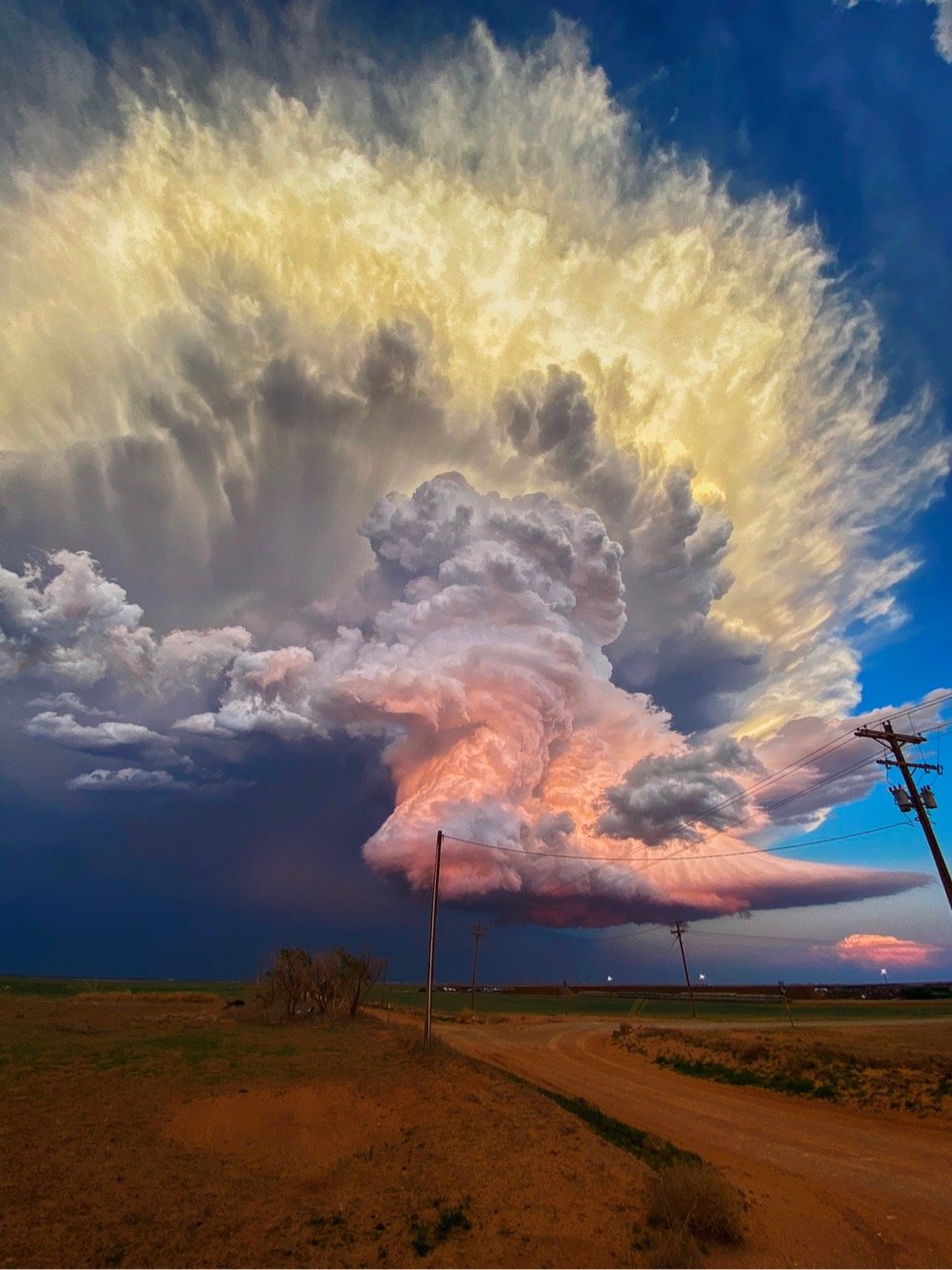
Photo by Laura Rowe. Wow. Evocative of Milton Glaser’s Bob Dylan poster. (via @mathowie)
Rick Steves: Germany’s Fascist Story
Rick Steves’ travel shows and videos typically highlight the positive aspects of travel destinations in Europe and around the world. But more recently, he’s also been making shows about Europe’s unpleasant past. In 2019, he did an hour-long TV special about the history of fascism in Europe
Because Steves hosts a travel show, they visit some of the places where this history played out, including Nuremberg, Auschwitz, and Rome, talk to historians and tour guides, and discuss fascist and anti-fascist art, including Picasso’s Guernica.
And earlier this year, Steves made a similar show that focused just on Germany, embedded above.
Traveling across Germany, we learn how fascism rose and then fell, taking millions of people with it. Visiting actual locations — from Munich to Nürnberg to Berlin — we trace the roots of Nazism in the aftermath of World War I, when masses of angry people were enchanted by Hitler. We explore the totalitarian society Hitler built, and see the consequences: genocide and total war. Learning from Germany’s fascist story, we can recognize that hateful ideology as well as the tricks of wannabe dictators in our own age.
(via open culture)
Novelty is the key to understanding the pandemic. “SARS-CoV-2 is new to our immune systems. That makes it very dangerous. Viruses that are new to us spread faster and are more lethal than old familiar ones.”
A profile of Shayne Bushfield and the relatively small online community he runs, LearnedLeague. “What Bushfield wants is to re-create, over and over, the experience of playing trivia with his friends at the office.”
Barry Jenkins Films the Gaze of His Ancestors
While he was filming the TV adaptation of Colson Whitehead’s The Underground Railroad, director Barry Jenkins was also working on this piece, entitled The Gaze. It’s a 50-minute, non-narrative video portrait of several of the show’s actors dressed in their period clothes, wordlessly looking into the camera.
I don’t remember when we began making the piece you see here. Which is not and should not be considered an episode of The Underground Railroad. It exists apart from that, outside it. Early in production, there was a moment where I looked across the set and what I saw settled me: our background actors, in working with folks like Ms. Wendy and Mr. and Mrs. King — styled and dressed and made up by Caroline, by Lawrence and Donnie — I looked across the set and realized I was looking at my ancestors, a group of people whose images have been largely lost to the historical record. Without thinking, we paused production on the The Underground Railroad and instead harnessed our tools to capture portraits of… them.
What flows here is non-narrative. There is no story told. Throughout production, we halted our filming many times for moments like these. Moments where… standing in the spaces our ancestors stood, we had the feeling of seeing them, truly seeing them and thus, we sought to capture and share that seeing with you.
(via the morning news)
An Infinite Hotel Runs Out of Rooms
This video from Veritasium is a nice explanation of the mathematician David Hilbert’s paradox of the Grand Hotel, which illustrates that a hotel with an infinite number of rooms can still accommodate new guests even when it’s full. Until it can’t, that is. See also Steven Strogatz’s explanation of Hilbert’s infinite hotel and how Georg Cantor’s discovery of different types of infinities complicated the hotel’s hospitality. (via digg)
TIL that my home internet service (that I use for producing @kottke) is not actually “broadband”. No wonder my kids complain about Fortnite lagging.
The Sparks Brothers
Edgar Wright has directed a documentary on a band called Sparks, which was formed by brothers Ron & Russell Mael in 1967 and the trailer (above) hails as “your favorite band’s favorite band”.
How can one rock band be successful, underrated, hugely influential, and criminally overlooked all at the same time? Edgar Wright’s debut documentary THE SPARKS BROTHERS, which features commentary from celebrity fans Flea, Jane Wiedlin, Beck, Jack Antonoff, Jason Schwartzman, Neil Gaiman, and more, takes audiences on a musical odyssey through five weird and wonderful decades with brothers/bandmates Ron and Russell Mael celebrating the inspiring legacy of Sparks: your favorite band’s favorite band.
The Sparks Brothers will be in theaters on June 18.
Watch as David Hockney Pages Through His Sketchbook
This is a treat: artist David Hockney wordlessly flipping through one of his sketchbooks from 2019 for 6 minutes. For the first few minutes, I thought that some verbal annotation would be nice, but it’s actually perfect as-is — you can just focus on looking. (via open culture)
“Maybe We Need Masks Indoors Just a Bit Longer”
Since yesterday’s announcement, I’d been feeling uneasy about the CDC’s decision to update its guidance to state that fully vaccinated people don’t need to wear masks in most situations indoors or out. Zeynep Tufekci’s piece in the Times nails why.
It’s difficult for officials to issue rules as conditions evolve and uncertainty continues. So I hesitate to question the agency’s approach. But it’s not clear whether it was responding to scientific evidence or public clamor to lift state and local mandates, which the C.D.C. said could remain in place.
It might have been better to have kept up indoor mask mandates to help suppress the virus for maybe as little as a few more weeks.
The C.D.C. could have set metrics to measure such progress, saying that guidelines would be maintained until the number of cases or the number vaccinations reached a certain level, determined by epidemiologists.
The vaccine is on its way to controlling Covid-19 in the US — but we’re not there yet. We’re not the UK or Israel…they’re further along in their vaccination campaigns and their daily cases and deaths are way down, warranting behavioral changes. In the US, over 600 people/day are still dying of Covid-19 and our case positivity rate is still above 3%. Too many people, including almost all children, are still vulnerable and as Tufekci says, the CDC could have waited a few more weeks to more quickly drive down the virus levels.
Update: The CDC’s move has been sharply condemned by National Nurses United, the nation’s largest union of registered nurses:
“The union noted that more than 35,000 new cases of coronavirus were being reported each day and that more than 600 people were dying each day. “Now is not the time to relax protective measures, and we are outraged that the C.D.C. has done just that while we are still in the midst of the deadliest pandemic in a century,” Ms. Castillo said.”
And Ken Schultz notes that the needle the CDC is trying to thread here might not work out the way that they’d hoped.
Imagine the social preference ordering is:
1. Unvaccinated wear masks, vaccinated don’t.
2. Everyone wears masks.
3. No one wears masks.Selfish, short-sighted behavior and the inability to monitor vaccination status mean that, in trying to get #1, you can end up at #3.
So I trust the CDC’s position that #1 is socially desirable from a scientific perspective. But by undermining mask mandates, they have made it more likely that we end up in #3, which science says is still risky. Living with #2 for now respects both science and social science.
A 12-Mile Video Walking Tour of Paris
Walking, cities, Paris, and YouTube are four of my favorite things, so this 5.5-hour, 12-mile video walking tour of Paris is right up my alley. Along the way, they visit the Notre Dame, the Arc de Triomphe, the market on Rue Mouffetard, the Jardins du Luxembourg, the Louvre, the Eiffel Tower, and lots more. If you turn the closed captions on, you can read about the histories of the places as the walk progresses. Hopefully this will tide me over until I can visit again. (via open culture)
Banksy Graffitied Walls And Wasn’t Sorry
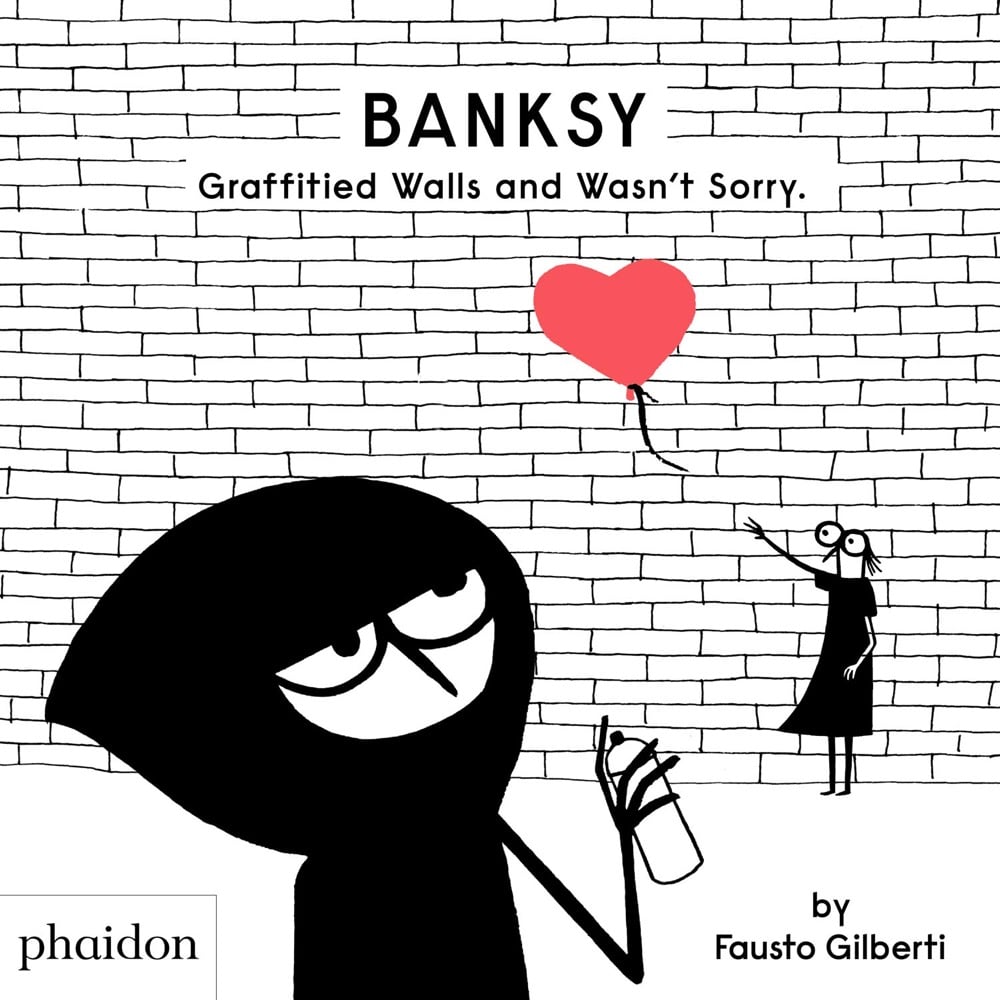
Banksy Graffitied Walls And Wasn’t Sorry is biography of street artist Banksy written for children by Fausto Gilberti. Gilberti has also written kid’s books about other artists: Jackson Pollock Splashed Paint and Wasn’t Sorry, Yayoi Kusama Covered Everything in Dots and Wasn’t Sorry, and Yves Klein Painted Everything Blue and Wasn’t Sorry.
Lovely and insightful reflections on 20 years of blogging from Cory Doctorow. I nodded along to almost all of this.
Fauxliage - Disguised Cell Phone Towers

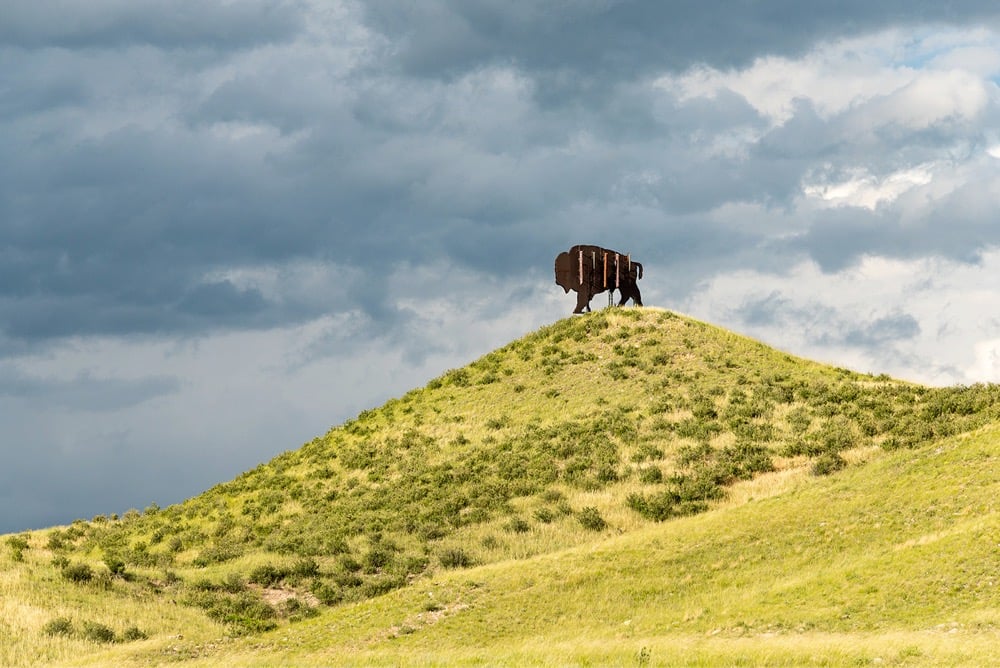

For the past several years, Annette LeMay Burke has been traveling the American West in search of disguised cell phone towers, collected in a project she calls Fauxliage.
As disguised cell phone towers proliferate, I find it ironic that instead of providing camouflage, their disguises actually unmask their true identities. The towers have an array of creative concealments. They often impersonate trees such as evergreens, palms, and saguaros. Some pillars serve other uses such as flagpoles or iconographic church crosses. Generally the towers are just simulacra. They are water towers that hold no water, windmills that provide no power, and trees that provide no oxygen. Yet they all provide five bars of service.
The photos are also available in book form. (via the morning news)
CDC says vaccinated Americans can go maskless outdoors and indoors in most situations. I worry this is premature.
David Bowie as Tilda Swinton and Tilda Swinton as David Bowie
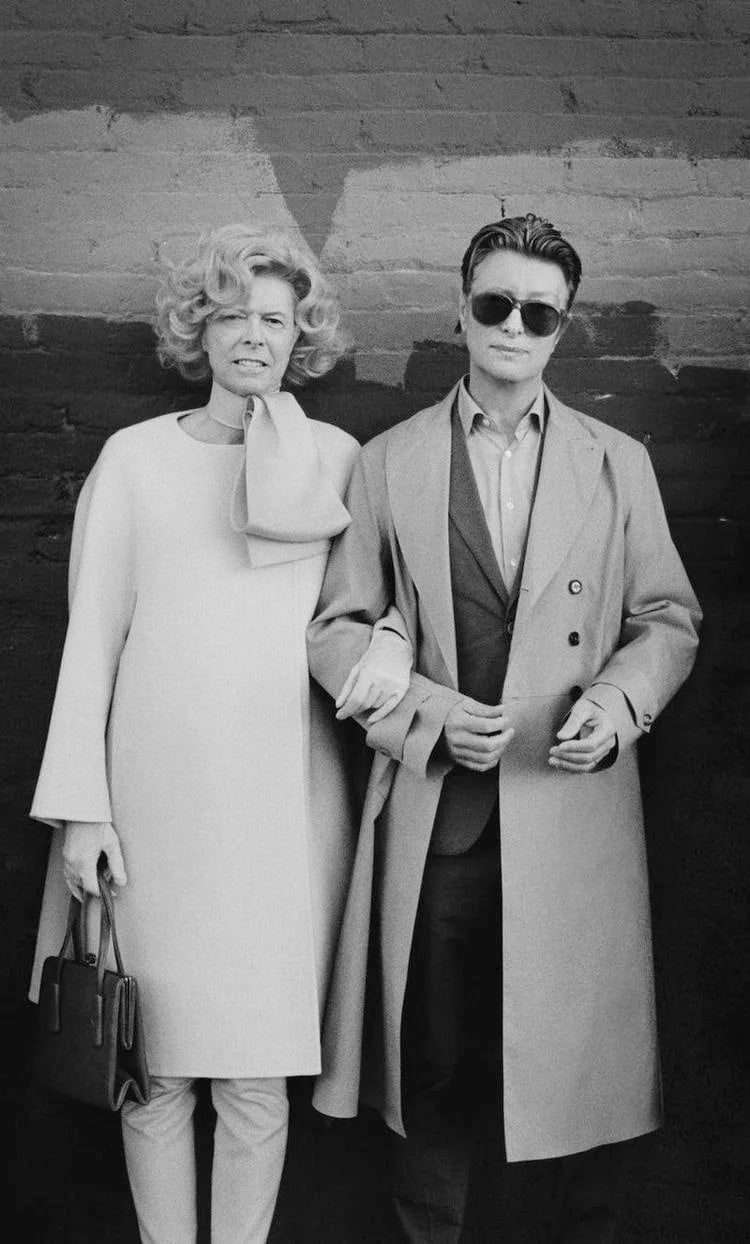
It’s photoshopped (the original is here) but still. Mercy.
Everyday Objects, Sliced


Fabian Oefner takes physical objects apart and puts them back together into exploded/fragmented sculptures.
The sculptures of the Heisenberg Series are based on Werner Heisenberg’s famous Uncertainty Principle. This theory states, that you can not measure two separate parameters of a particle simultaneously. You can either determine one parameter and ignore the other or vice versa, but you can never know everything at once.
Oefner took this idea from the world of physics and created an artistic equivalent of it. The sculptures are made of five different everyday objects: shoes, a clock, a tape recorder and a black box. The artist filled these with resin and carefully sliced them into hundreds of individual parts. He then rearranged the slices into a distorted new version of the object, that lets you see its inner workings.
Through this transformation, the objects have a peculiar effect on their observer: When you look at them from a distance, you can easily identify the object. However, if you start to get closer to observe its inner workings, the shape of the object starts to get distorted and vanishes completely. As an observer you are never able to observe the object as a whole and its inner workings simultaneously. The more accurately we see one view, the less clearly we see the other.
When I first glanced at Oefner’s images, I thought they were uninterestingly digital — 3D-generated images digitally manipulated or some such — but they’re real-world things actually sliced apart. (via colossal)
Bart Simpson feat. Daft Punk & Giorgio Moroder
Part of what makes this so good & funny is the obvious level of care put into making it, right down to the smallest details. The audio distortion? Perfect lip syncing? The Doppler effect?! It’s just a meme, you didn’t have to go so hard! (via the xoxo slack)
“Renewable Energy Is Suddenly Startlingly Cheap”
Writing in the New Yorker and citing a report by Carbon Tracker Initiative, Bill McKibben provides some hope that we can address the climate crisis.
Titled “The Sky’s the Limit,” it begins by declaring that “solar and wind potential is far higher than that of fossil fuels and can meet global energy demand many times over.” Taken by itself, that’s not a very bold claim: scientists have long noted that the sun directs more energy to the Earth in an hour than humans use in a year. But, until very recently, it was too expensive to capture that power. That’s what has shifted — and so quickly and so dramatically that most of the world’s politicians are now living on a different planet than the one we actually inhabit. On the actual Earth, circa 2021, the report reads, “with current technology and in a subset of available locations we can capture at least 6,700 PWh p.a. [petawatt-hours per year] from solar and wind, which is more than 100 times global energy demand.” And this will not require covering the globe with solar arrays: “The land required for solar panels alone to provide all global energy is 450,000 km2, 0.3% of the global land area of 149 million km2. That is less than the land required for fossil fuels today, which in the US alone is 126,000 km2, 1.3% of the country.” These are the kinds of numbers that reshape your understanding of the future.
But world governments will need to invest in renewable energy sooner rather than later and fossil fuel companies will fight tooth and nail to slow the transition to renewables. If they win in slow-walking the response to the climate crisis, as McKibben puts it, “no one will have an ice cap in the Arctic, either, and everyone who lives near a coast will be figuring out where on earth to go”.
Recent studies found that men who had Covid-19 were more likely to have severe erectile dysfunction, lower sperm counts, and decreased genital size. So…get vaccinated maybe, hesitant gents?
Winners of the 2021 Type Directors Club Design Awards

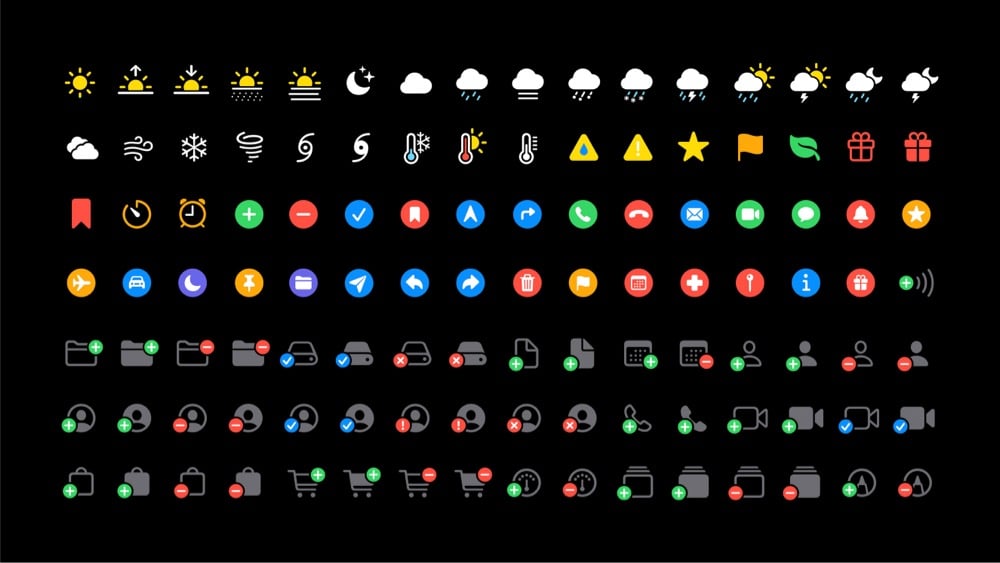


The Type Directors Club has announced the winners of their two design competitions: TDC67 Communication Design and 24TDC Typeface Design. (via print)
Who Invented Heavy Metal?
In this video, Polyphonic explores the roots of heavy metal, from the increasingly distorted guitar sounds in 50s blues to the fast-picked guitars of surf rock to the heavy rock of English groups like The Who and The Beatles to the first metal bands, Black Sabbath and Deep Purple. (via open culture)
A high-level report concludes that the WHO and national leaders should have acted faster and more decisively to try to curb the pandemic. “It is glaringly obvious that February 2020 was a lost month.”
11 Reasons to Keep Wearing a Mask After You’re Vaccinated and the Pandemic is “Over”

- You 100% do not want to get Covid-19.
- You are immunocompromised. Millions of people have immune conditions that make contracting Covid-19 much more dangerous for them.
- You’re traumatized from “the mental and emotional toll of the last year”.
- Because you need to be around people you suspect may not be vaccinated or taking Covid-19 seriously (e.g. as part of your job).
- You’re not feeling well and want to make sure to protect others around you.
- Because you want to signal to others that you are being safe and thinking of the health and wellness of those around you.
- You live in a household with unvaccinated people (kids, for example) and want to make sure to protect them.
- Because your personal risk tolerance is lower than other people’s.
- You need some time to feel comfortable enough taking your mask off around others after more than a year of that very behavior being dangerous.
- Because you want to.
- But mostly because it is NONE OF ANYONE’S GODDAMN CONCERN if you choose to keep wearing a mask. Fuck off! Mind your own business!
The Emerging Movement for Police and Prison Abolition. “I want [to] build up another world that is rooted in collective wellness, safety, and investment in the things that would actually bring those things about.”
“The Woman Who Made van Gogh”

There are certain writers that, when I see their byline, I read their stuff, even if it takes me a few weeks to find the time. Ever since reading his excellent The Island at the Center of the World, Russell Shorto has been one of those writers. His latest piece, The Woman Who Made van Gogh, tells the story of Jo van Gogh-Bonger who, after both her husband Theo and her brother-in-law Vincent died within a year and a half of each other, worked tirelessly for decades to get Vincent’s work out into the world.
The brothers’ dying so young, Vincent at 37 and Theo at 33, and without the artist having achieved renown — Theo had managed to sell only a few of his paintings — would seem to have ensured that Vincent van Gogh’s work would subsist eternally in a netherworld of obscurity. Instead, his name, art and story merged to form the basis of an industry that stormed the globe, arguably surpassing the fame of any other artist in history. That happened in large part thanks to Jo van Gogh-Bonger. She was small in stature and riddled with self-doubt, had no background in art or business and faced an art world that was a thoroughly male preserve. Her full story has only recently been uncovered. It is only now that we know how van Gogh became van Gogh.
Because of her work, Vincent van Gogh is a household name all over the world and even the way people think about artists and their art forever changed.
Health Conspiracy Theorists Hate Living in the World They Helped Create. “By fighting the most commonsense public health measures at every turn, the health conspiracy theorists helped create a climate where more restrictive ones are looking…necessary.”
The Final Border Humanity Will Never Cross
This video focuses on one of my favorite astrophysics facts: 94% of the observable universe is permanently unreachable by humans. (Unless we discover faster-than-light travel, but that’s fantasy at this point.)
This expansion means that there is a cosmological horizon around us. Everything beyond it, is traveling faster, relative to us, than the speed of light. So everything that passes the horizon, is irretrievably out of reach forever and we will never be able to interact with it again. In a sense it’s like a black hole’s event horizon, but all around us. 94% of the galaxies we can see today have already passed it and are lost to us forever.
“Since you started watching this video, around 22 million stars have moved out of our reach forever.” And future generations, billions of years from now, won’t even be able to see any other galaxies or detect cosmic background radiation, making knowledge about the Big Bang impossible.
The Pantone Pee Chart
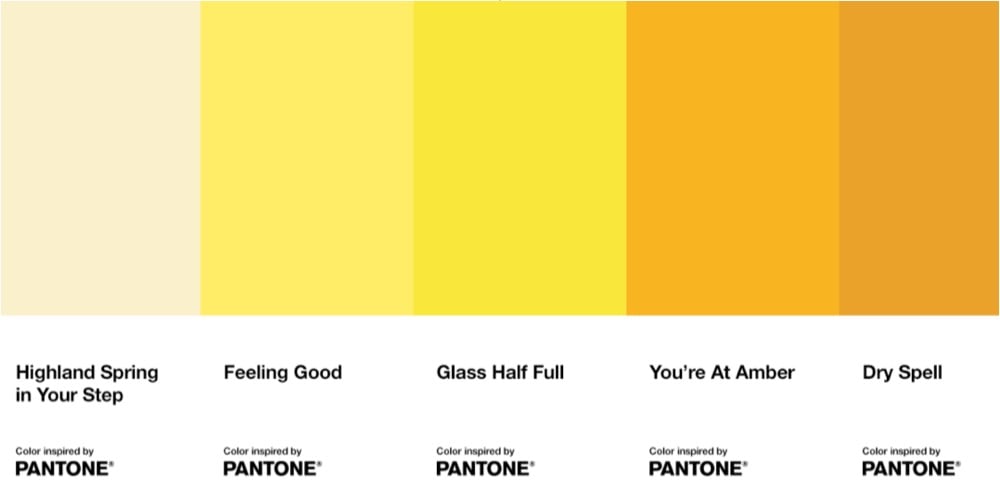
Urine color is an indicator of how hydrated you are and Pantone are the color experts, so of course they’ve teamed up with a Scottish bottled water company to produce a chart with 5 color gradations that help you determine your hydration level. But 10 glasses of water a day?! I’m not sure the science supports that, particularly since we get a lot of our recommended intake from regular food & beverage consumption.
It remains unclear where the “8 x 8” water intake recommendation comes from. Perhaps, this two-liter intake threshold is derived from a misinterpretation of original recommendations offered by the U.S. Food and Nutrition Board in 1945 as well as the 2017 European Food Safety Authority, which states the daily recommended amount of water includes all beverages plus the moisture contained in foods.
This means that the moisture contained in foods, especially fresh fruits, sodas, juices, soups, milk, coffee and, yes, even beer, contributes to this daily recommended water requirement. These guidelines go on to suggest that most of the recommended water content can be accomplished without drinking additional cups of plain water.
(via print)
Governor Abbott, Will You Save My Life?
Quintin Jones murdered his aunt in 1999 and is scheduled to be executed on May 19, 2021. He admits his guilt, his family has forgiven him, and in this video, he shares his thoughts about personal growth & death and asks Texas governor Greg Abbott to spare his life.
During his 21 years on death row, Quin has been the epitome of a prison success story. He entered at an unimaginable low, as lost as a soul can be. And through prayer, sobriety, reconciliation with his family, and longstanding correspondence with pen pals, he has found a way to lead a meaningful life, and even to enhance the lives of others. The victim’s family — who is also Quin’s family — has forgiven him.
Emotionally, intellectually, and psychologically, human beings are ships of Theseus — we are not the same people at 30 as we were at 20 or will be at 40. The death penalty is immoral, full stop. The sooner our system of retributive justice is replaced with restorative justice, the healthier and safer our communities and society will be.
On Monday, England, Scotland, and Northern Ireland recorded zero deaths from Covid-19. Lockdown + strong vaccine rollout saved thousands of lives.
Colette
Colette is a remarkable short documentary that won the Oscar this year in the Documentary Short Subject category. You can watch the film online courtesy of The Guardian.
90-year-old Colette Marin-Catherine confronts her past by visiting the German concentration camp Mittelbau-Dora where her brother was killed. As a young girl, she fought Hitler’s Nazis as a member of the French Resistance. For 74 years, she has refused to step foot in Germany, but that changes when a young history student named Lucie enters her life. Prepared to re-open old wounds and revisit the terrors of that time, Marin-Catherine offers important lessons for us all.
Here’s an interview with the filmmakers. From our present historical distance, the horrific story and lessons of Nazism seem fairly straightforward. But as Colette shows, when you delve into the individual stories, the truth of people’s grief & experiences gets complicated. These stories are important to hear and to tell so we remember the real, human, feeling truth of how individual lives were damaged and wasted by the actions of the large and powerful.
Sports From Above




Photographer Brad Walls (Insta) makes aerial photos of people playing sports, providing a new angle on the actions of divers, gymnasts, tennis players, synchronized swimmers, and figure skaters. (via petapixel)
Vaccine Side Effect, or Have You Just Been Alive for 40 Years? “Q: Are you experiencing unusual nausea? A: I am nauseous, but it could be because I ate some fried food yesterday. Fried food upsets my stomach. So does spicy food. So does too much fiber.”
Half-Renovated Houses



When the mining industry declined in the Ruhr region of Germany, workers began selling their houses…but only half of them. Colossal explains:
When the once burgeoning coal industry in Ruhrgebiet, Germany, began to decline, many of the workers’ apartments were sold off. Oftentimes, new owners only purchased half of the building — miners maintained a lifelong right of residence to their quarters — creating a stark split between the left and right sides of the structure.
Photographer Wolfgang Fröhling documented a number of these split-personality houses where the two sides of the buildings have diverged post-sale, a particularly stark representation of gentrification.
It seems that con man Frank Abagnale, the basis of Spielberg’s ‘Catch Me if You Can’, made up many of his criminal exploits. We really should have seen this coming…
US Quarters to Honor Maya Angelou and Sally Ride

Starting in 2022, the US Mint will release into circulation 20 quarters featuring notable American women as part of the American Women Quarters Program. From the US Mint:
The American Women Quarters may feature contributions from a variety of fields, including, but not limited to, suffrage, civil rights, abolition, government, humanities, science, space, and the arts. The women honored will be from ethnically, racially, and geographically diverse backgrounds. The Public Law requires that no living person be featured in the coin designs.
The Mint recently announced that the first two women to be featured are astronaut Sally Ride and writer Maya Angelou. The designs for the two new coins were revealed in the NY Times yesterday.
The World’s Most Beautiful Gas Stations





I pulled some of my favorite images of gas stations from the following sources: Get Pumped: 8 Filling Stations Fueled By Great Design, It’s a Gas!: The Allure of the Gas Station, Gas Station Design — The World’s 10 Best Filling Stations for 2017, It’s Weird, But We’re Super Inspired by Gas Station Design, and Sometimes, Gas Stations Are Beautiful. May these buildings and their less attractive brethren soon fade into obsolescence, be converted to electric car/bike charging stations, or be repurposed for other things.
Thom Yorke, From The Basement
In 2005, Thom Yorke recorded a 15-minute set for the From The Basement series — just him, a piano, and a microphone. He sang Videotape from In Rainbows and Last Flowers & Down Is the New Up from In Rainbows Disk 2. Lovely.
See also Radiohead, From The Basement.
Low Poly Landscapes




Lovely work here by Elyse Dodge — these look like half-finished renderings by the machine that’s simulating our universe. You can keep up with her work on Instagram or get some for yourself in her shop. (via moss & fog)
Shadows in the Sky
Always a treat to watch a new time lapse storm video from Mike Olbinski. It’s in 8K as well, so if you have the bandwidth and the screen resolution, this is going to look extra good. You can see more of Olbinski’s breathtaking videos here as well as plenty more cloud content. kottke.org: home of fine cloud products. (via colossal)
The Otherworldly Sounds of Ice
The holes drilled into Arctic, Antarctic, and glacial ice to harvest ice cores can be up to 2 miles deep. One of my all-time favorite sounds is created by dropping ice down into one of these holes — it makes a super-cool pinging noise, as demonstrated in these two videos:
Ice makes similar sounds under other conditions, like if you skip rocks on a frozen lake:
Or skate on really thin ice (ok this might actually be my favorite sound, with apologies to the ice core holes):
Headphones are recommended for all of these videos. The explanation for this distinctive pinging sound, which sounds like a Star Wars blaster, has to do with how fast different sound frequencies move through the ice, as explained in this video:
(via the kid should see this)
The Fashionable Mark Bryan
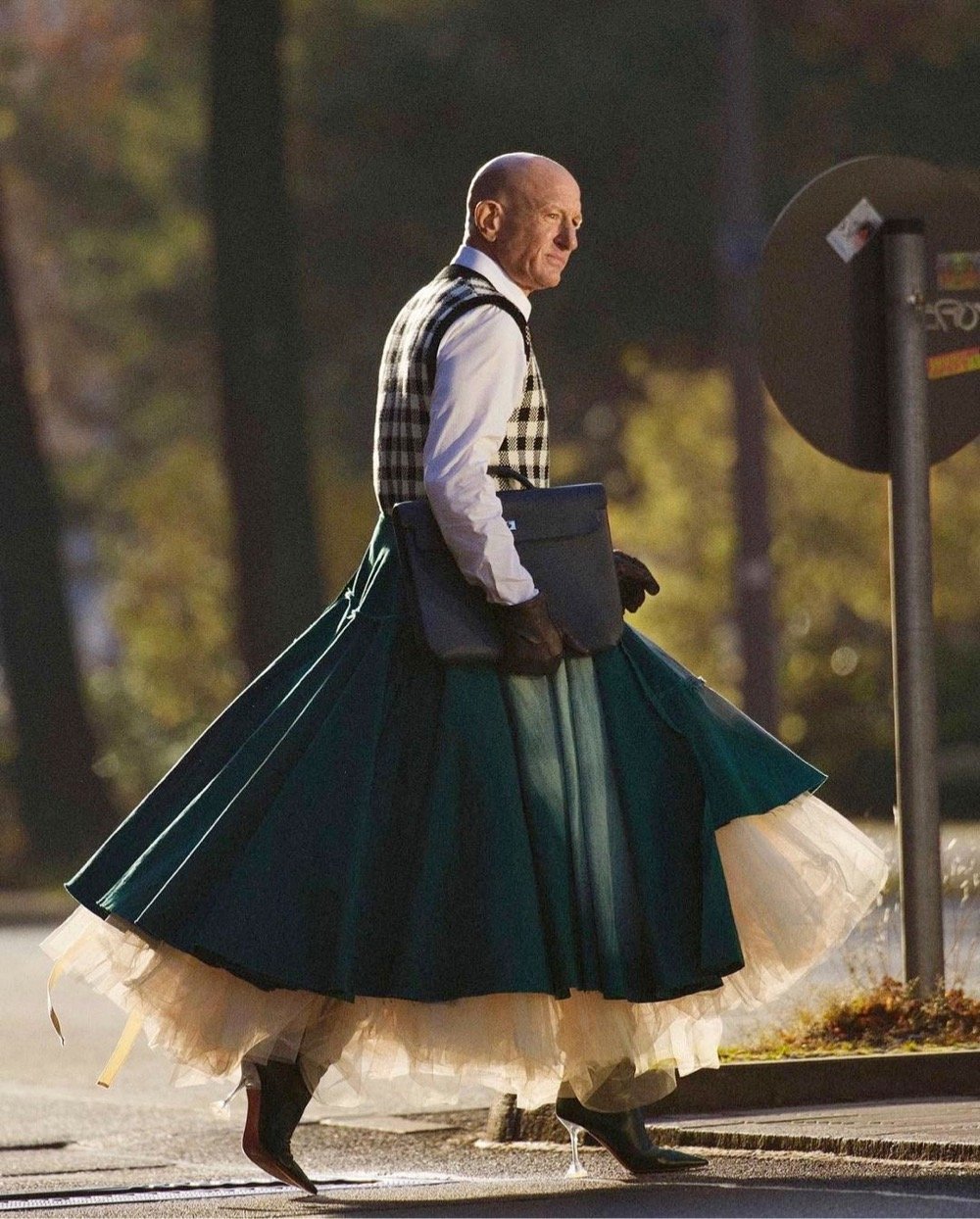


For the past year, robotic engineer Mark Bryan has amassed hundreds of thousands of followers on Instagram by cataloguing his daily outfits that include skirts and heels. From a profile in Interview:
By all accounts, Mark Bryan is an average, run-of-the-mill guy. The 61-year-old grandfather of four has been happily married to his wife for the past 11 years. In 2010, he moved from Texas to a town near Schwäbisch Hall, Germany, where he now works in robotics engineering and coaches a local football team. He loves cycling and fast cars and beautiful women, and he tries to exercise at least twice a week. Oh, and he looks great in a pencil skirt and a pair of six-inch stilettos.
He looks fantastic. If I have legs like that when I’m 61, I might wear skirts and heels all the time too. Here’s the caption from his first Instagram post in Feb 2020:
I am just a normal happily married straight guy that loves Porsche’s, beautiful women, and likes to incorporate a skirt and heels into his daily wardrobe. Clothes and shoes should have no gender.
A list of the 100 best sitcoms of all time. Frasier over Fleabag? No thank you.
How Internal Combustion Engines Work

Although it was first developed in the 19th century, the internal combustion engine is perhaps the defining technology of the 20th century. If you don’t quite know how they work, this fantastic interactive demonstration from Bartosz Ciechanowski is a great place to start. I lived in the country when I was a kid and helped my dad, who was a crackerjack mechanic, out in the garage a lot, so I know how engines work, but even so this is really illuminating, especially when it comes to the details. Turns out that an engine is basically just tiny cannons attached to a crank — and from thence the rapid industrialization of the world (and all the resulting benefits and challenges).
See also some of Ciechanowski’s other interactive explainers like Cameras and Lenses, Earth and Sun, and Gears.
A Blinking Map of the World’s Lighthouses

Courtesy of Geodienst, this is a map of the world’s lighthouses. Where the data is available (and you can see it’s quite sparse for some areas of the world), the map shows the location, color, range, and flashing frequency/pattern of each lighthouse. The color and flashing pattern of a lighthouse is called the characteristic. Each lighthouse has a different characteristic so that mariners can tell them apart and to indicate different water areas. (via strange maps)
Seth Rogen: Tales from the Nineties Bar Mitzvah Circuit
The New Yorker is running an excerpt from Seth Rogen’s new memoir, Yearbook (ebook), which will be out next week. When you’re reading this, remember to hear Rogen’s voice in your head; it makes it so much better.
The movie “Tombstone” came out in 1993, and, although it wasn’t a massive box-office or critical hit (the New York Times called it “morally ambiguous”), it made an impression on many, mostly owing to an amazing performance by Val Kilmer that was publicly praised by President Bill Clinton — which is the single most nineties sentence one could write. As 1994 rolled around, a young me was smitten with not only Kilmer’s performance as Doc Holliday but the entire Western aesthetic. The result? A fuckload of vests.
I could not own enough vests. I’d have bought more torsos just to wear them all if that were an option. A vest packed me in, gave me shape, and, most important, kind of made me feel like a cowboy who was dying of tuberculosis, which Kilmer had somehow made seem super-awesome. I also wore a pocket watch, which, in a truly impressive act of delusion, I’d convinced myself was cool.
It wasn’t.
Weekend after weekend, a slow song would come on, boys would ask girls to dance, girls would ask boys to dance, and I’d generally find myself standing off to the side, watching it all happen, spinning my pocket watch like some sort of nineteen-twenties Mafia snitch.
I’m a little older than Rogen — Tombstone hit when I was in college — and seeing the film didn’t make me want to wear vests, but that didn’t stop me and my friends from going around quoting the film at length, pretty much all of the time for months on end. One of our favorites — I can’t remember which of us originally came up with this — was reworking Doc Holliday’s line about his partner not wearing a bustle (seen at the beginning of this clip) into: “Kate, you’re not doing The Hustle. How doo doo doo doodoo doodoo doo doo…” That’s some prime middle school humor right there.
All These Balls Are the Same Color?!

Oh dear, this illusion just totally broke my brain. No can write now. Somehow all same ball colors. What world? What earth? Why live? (Even after reading and seeing the explanation, I had to drag this into my photo editing app to verify it with my own eyes. True true. Oh, humanity.) (via @flyosity)
A Reevaluation of Jimmy Carter’s Presidency
A new documentary film called Carterland and Jonathan Alter’s biography His Very Best: Jimmy Carter, a Life (ebook) are among the recent media attempting to reconsider and recontextualize the presidency of Jimmy Carter. From Megan Mayhew Bergman in The Guardian:
“Here’s what people get wrong about Carter,” Will Pattiz, one of the film’s directors tells me. “He was not in over his head or ineffective, weak or indecisive — he was a visionary leader, decades ahead of his time trying to pull the country toward renewable energy, climate solutions, social justice for women and minorities, equitable treatment for all nations of the world. He faced nearly impossible economic problems — and at the end of the day came so very close to changing the trajectory of this nation.”
Will’s brother, Jim, agrees. “A question folks should be asking themselves is: what catastrophes would have befallen this country had anyone other than Jimmy Carter been at the helm during that critical time in the late 1970s?”
I’m gonna need a three-episode series about Carter on You’re Wrong About, stat. If there’s any justice in the world (wait, don’t answer that), in 50 years’ time Ronald Reagan’s presidency will be considered the disaster that is was and Carter’s will look better in comparison.
If you’re interested in seeing Carterland, it looks as though it’s not out widely quite yet — the only place I could even find a trailer is on this Atlanta Film Festival page (click “Play Trailer” at the bottom of the page).
Michael Lewis’s New Book About the Pandemic (and Who Should Have Been in Charge)
When large, seemingly sudden systemic failures occur, Michael Lewis is one of those writers who’s just waiting to pounce on it and tell us all about it. So it’s not a surprise to see that his new book comes out tomorrow: The Premonition: A Pandemic Story (ebook). From a Time interview with Lewis:
The Premonition makes sense of the COVID-19 pandemic through three people, each of whom knows a great deal about how to stop it-and none of whom is ever approached by the U.S. government: A “redneck epidemiologist” named Carter Mercher who had written the closest thing the government had to a pandemic strategy; Joe DeRisi, a McArthur Fellow who once built a chip containing all the world’s viruses; and Dr. Chastity Dean, an obscure local health official in California.
And from a mainly positive review by the NY Times’ Jennifer Szalai:
True to form, Lewis makes few grand claims for what he finds, preferring instead to let the curated details speak for themselves. “I like to think that my job is mainly to find the story in the material,” he writes in the prologue. “I think this particular story is about the curious talents of a society, and how those talents are wasted if not led. It’s also about how gaps open between a society’s reputation and its performance.”
The main question running through “The Premonition” is how, when it came to the initial Covid response, a very rich country that was ranked first globally in pandemic readiness in 2019 managed to incentivize almost all the wrong things.
Of course, this is the reality that all of us have been living for the past year, so the failures of the system don’t come as much of a surprise. Still, Lewis finds ways not just to showcase the brokenness of the system writ large but to zoom in on the sand in the gears.
But Szalai also notes the drawback of most of Lewis’s books:
This method of hewing so tightly to his characters’ perspectives gives Lewis’s narrative its undeniable propulsion, but it also comes at a cost. He doesn’t supply any endnotes, or even a sense of how many people he talked to. His main characters are presented to us as they would undoubtedly like to appear: charmingly obsessive, unwaveringly principled and unfailingly right.
You can listen to a brief interview with Lewis on NPR’s Morning Edition.
An Iconic Prince Guitar Solo, Reborn
In a career filled with iconic performances, one of the standout Prince moments came at the 2004 Rock and Roll Hall of Fame induction ceremony for George Harrison. On stage to play While My Guitar Gently Weeps were Harrison’s son Dhani, music legends Tom Petty, Jeff Lynne, and Steve Winwood, and Prince. At about 3 minutes and 30 seconds in, Prince absolutely rips the place apart with a 3-minute guitar solo for the ages. If you’ve never seen this, make sure you watch all the way to the end.
Video of the performance has been available online for years, but producer Joel Gallen recently uploaded a recut version (embedded above) that focuses more on Prince during the solo. As with all things Prince, Anil Dash shared some context for the performance, including this amazing detail about what happened to the guitar that Prince threw into the air: “long-time guitar tech Takumi Suetsugu caught the guitar & handed it to Oprah”. AS YOU DO. Dash also shared this photo by Afshin Shahidi of Prince walking, guitar in hand and seemingly unnoticed in NYC, to rehearsals for the Hall of Fame ceremony in question.
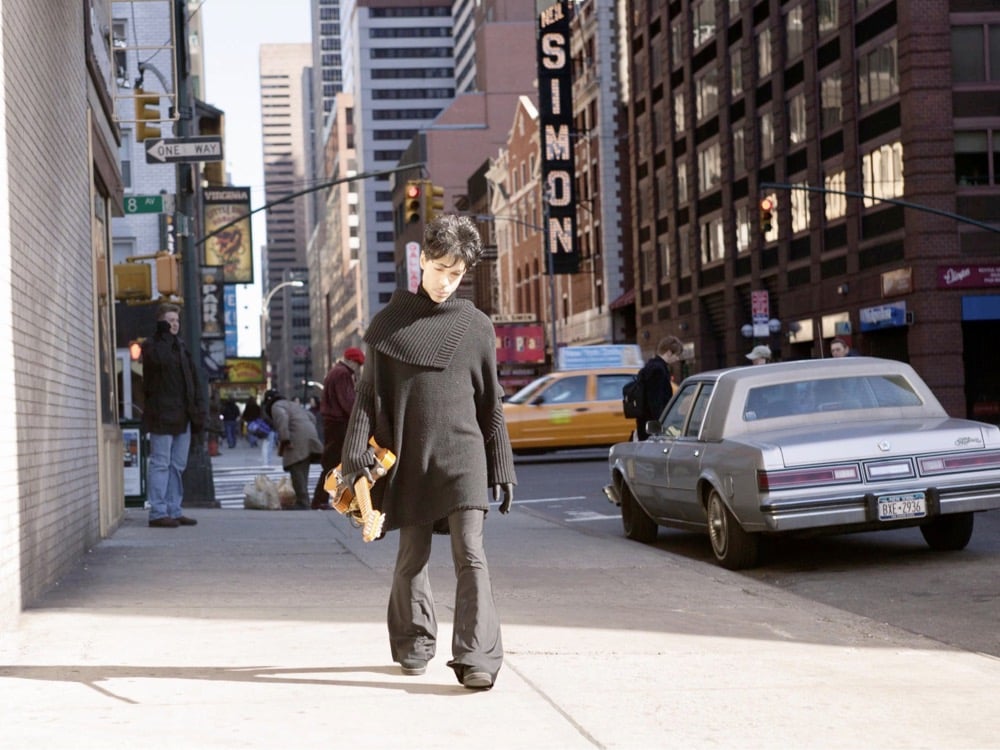
Update: This is a great oral history of the ceremony written in 2016.
Tom sort of went over to him and said, “Just cut loose and don’t feel sort of inhibited to copy anything that we have, just play your thing, just have a good time.” It was a hell of a guitar solo, and a hell of a show he actually put on for the band. When he fell back into the audience, everybody in the band freaked out, like, “Oh my God, he’s falling off the stage!” And then that whole thing with the guitar going up in the air. I didn’t even see who caught it. I just saw it go up, and I was astonished that it didn’t come back down again. Everybody wonders where that guitar went, and I gotta tell you, I was on the stage, and I wonder where it went, too.
When NYC’s Eleven Madison Park restaurant reopens, they will no longer serve meat or seafood due to environmental concerns. “What at first felt limiting began to feel freeing, and we are only scratching the surface.”
Aerial Footage of Chicago from a Dirigible (1914)
From the US National Archives, an 8-minute film of aerial footage filmed from a dirigible piloted by Roy Knabenshue in 1914. I am not super familiar with Chicago and the architecture of the time, but given the city’s role in the development & popularization of the skyscraper, I bet there are some amazing views in here of iconic buildings not so long after they were constructed as well as some buildings and spaces that no longer exist.
If you wish, you can also watch the upsampled, colorized, and “AI enhanced” version of this video. As I’ve said before, I’m not a huge fan of these, uh, restorations. We shouldn’t accept crappy colorization of historic B&W films just because an AI did it. (via @davidplotz)
Post-vaccination Inertia Is Real. “Readjusting our ideas about what’s safe is going to take time.”
A Revolutionary NES Tetris Technique Gaining Steam
The NES version of Tetris has been out in the world for more than 30 years now. Somehow, using the same controllers and human hands that have been in use all this time, a new technique has been invented that’s resulting in scores and maneuvers that no one using The Old Ways could have dreamed of. One YouTube commenter sums it up:
The fact that we are still out here revolutionizing the mere concept of pressing a button on a controller that is almost 40 years old. I love this community.
This is a great illustration of innovation in action. There’s a clearly new invention, based on prior effort (standing on the shoulders of giants), that allows for greater capabilities and, though it’s still too early to tell in this case, seems likely to shift power to people who utilize it. And it all takes place inside a small and contained world where we can easily observe the effects.
See also Jacob Sweet’s piece from the New Yorker a couple of months ago, The Revolution in Classic Tetris, which contains this unbelievable tidbit:
Dana Wilcox, one of the highest-scoring players on the Twin Galaxies leaderboard, discovered that she’d played for twenty years without knowing that the blocks could be spun in either direction.
(via robin sloan)
Reaching ‘Herd Immunity’ Is Unlikely in the U.S., Experts Now Believe. This has seemed the likely outcome for months now – simply not enough people are interested in the vaccine to get us there.




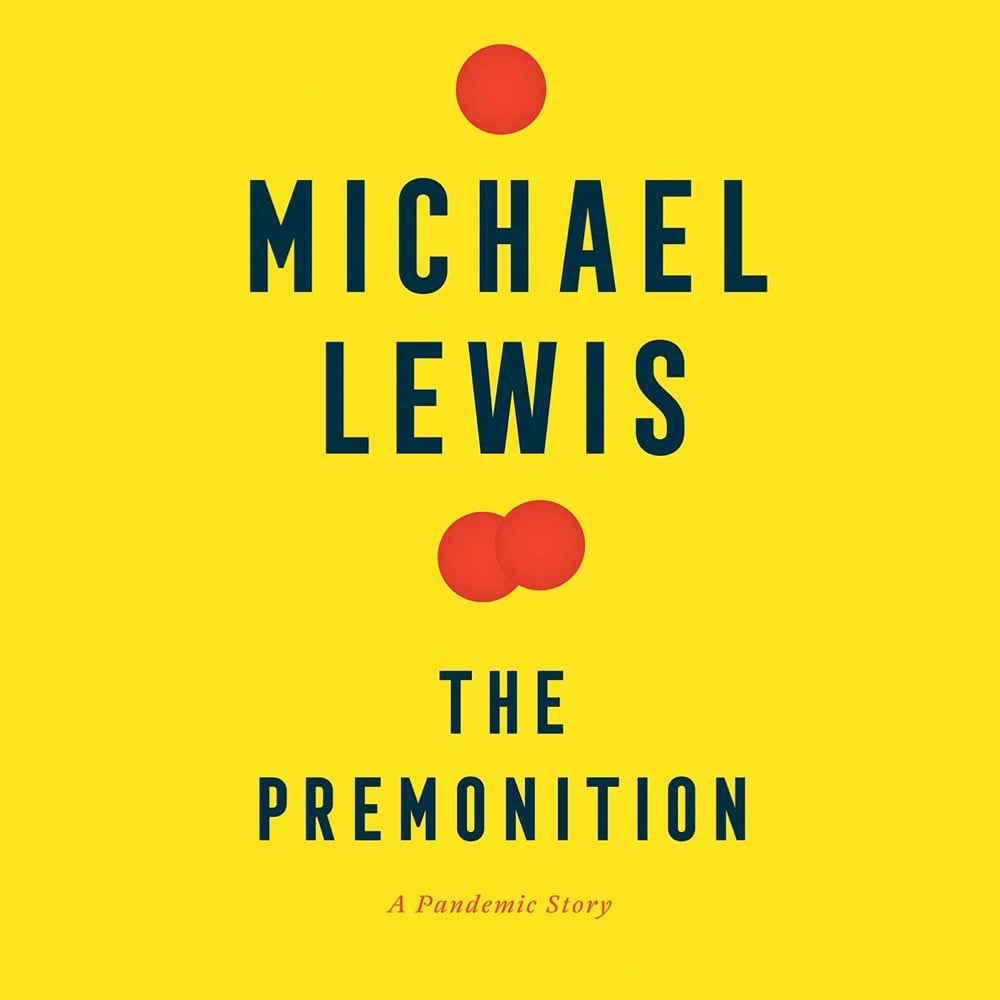
Stay Connected